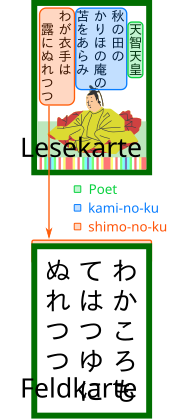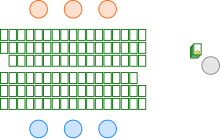Uta-Garuta
Uta-Garuta ( Japanese 歌 ガ ル タ or 歌 加 留 多 , z. German " Poem Cards ") describes Japanese card games whose cards are based on the poems ( Waka ) of the anthology Hyakunin Isshu . It is a sub-category of karuta . The prerequisite for playing most of the variants is to know all 100 poems by Hyakunin Isshu by heart . Since karuta is traditionally played in Japan at the New Year and many Japanese get to know the poems of the anthology through it, it also plays a cultural role.
description
The card game consists of 200 cards. For every poem by Hyakunin Isshu there is a reading card , called Yomifuda ( 読 み 札 , "card to read"), and an associated field card , Torifuda ( 取 り 札 , "card to take").
On the front of the reading cards there is a representation of the poet in Japanese style in the style of the Yamato picture , his name and the entire poem. Only the end of the poem, Shimo-no-ku ( 下 の 句 , "lower stanzas") is found on the field cards, written exclusively in Kana .
Until the Edo period , only the name of the poet and the upper stanzas could be seen on the reading cards, and the lower stanzas in italics on the field maps. Reading cards without a picture of the poet were also widespread until the middle of the Edo period, since the purpose of the game was originally solely to memorize the poems.
On Hokkaidō there is still an extraordinary variant of the cards, called Shimonoku-Karuta ( 下 の 句 か る た , " Undershoot Karuta"), in which the reading cards are also without a picture of the poet and only the lower stanzas of the poems, completely without the upper ones, to be read. The field maps are made of thicker wood and show the lower verses of poems in ancient italics.
Rules and variants
Most game variants are based on the same basic principle. A reader randomly chooses a reading card and reproduces the poem written on it. The task of the players is to find the corresponding field map as quickly as possible. Since many poems can be clearly identified after just a few syllables, it is possible for experienced players to determine the correct field map before hearing the lower stanzas. It is common that several groups / pairs of players play at the same time for a reader in the room.
Chirashidori
The Chirashidori ( 散 ら し 取 り ) is one of the traditional variants. It follows the principle of everyone against everyone .
- The reading cards are shuffled and given to the reader.
- The field cards are shuffled and distributed on the ground. Any number of players are positioned around them. So that no player is disadvantaged by only being able to see all the cards upside down, it must be ensured that the field cards, pointing in all directions, are laid out evenly.
- The reader randomly chooses a reading card and reads the poem written on it aloud.
- Each player tries to be the first to find the corresponding field card.
- When the correct field map is picked up, the reader advances to the next poem.
- If the players fail to find the correct card, the lower stanzas are repeated.
- If several players reach for the same card at the same time, the one whose hand is at the bottom has the right to pick up the card.
- If a wrong card is picked up (this occurrence is known as otetsuki ( お 手 つ き )), there are different penalties, but none of them are precisely defined as in other game variants (see below).
- The game ends as soon as the last card has been picked up. The winner is whoever has the most cards in his hands at the end.
Up until the Edo period it was common, and not only in the version of Chirashidori, for the reader to read only to the end of the upper stanzas, starting with the name of the poet. Today the poet's name is left out, but the entire poem is read aloud.
Inverted Chirashidori
In this variant, instead of the field cards, the reading cards are laid out as search cards, while the lower poem stanzas shown on the field cards are read out. One goal of the game is to recognize the poem from the lower stanzas. As in the normal game, whoever has the most cards in the end wins. Another special feature is due to the fact that even with the reading card poems Kanji are written - as opposed to only in Kana held Torifuda - there are frequent and unexpected confusion.
Gempei alleys
The Gempei-Gassen ( 源 平 合 戦 ) refers to the historical war between the warring families Minamoto (Genji) and Taira (Heike): there are also two parties facing each other in the game.
- As in Chirashidori, the cards are sorted according to reading and field cards and a reader is designated.
- The players split into two groups.
- The field cards are divided into stacks of 50 cards each; each group of players receives one and distributes the cards in three rows in front of them.
- As in Chirashidori, the players look for the field map belonging to the poem they have read aloud and pick it up as soon as it is found.
- If a card is picked up from one's own ranks, the process continues with the next poem, as with the Chirashidori.
- However, if the card picked up is one of the opponent's cards, the opposing team is given one of their own cards in exchange. A card handed over in this way is called Okurifuda ( 送 り 札 , "card sent").
- If a player picks up the wrong card, his team receives a card from the opposing ranks.
- The side that is first out of cards wins.
Goshiki-Hyakuninisshu
Goshiki-Hyakuninisshu ( 五色 百 人 一 首 , "five-color Hyakuninisshu") is a simplified game variant that requires a special set of cards. 20 of the 100 field and reading cards are combined into a group and identified by a uniform color (often used for the edge and back of the cards).
- One of the five colors (20 field and reading cards) is chosen. The remaining 160 cards are not part of the game.
- A reader is appointed.
- Two players compete against each other.
- Each player receives 10 field cards and positions them in front of him in 2 rows of 5 cards each.
- Reading, recording and sending cards conform to the rules of Gempei-Gassen
- If a player tries to pick up a wrong card ( Otetsuki ), he places one of the cards that he has won so far in the center of the field, face down, next to the remaining field cards. The player who picks up the next card correctly also receives the card that was placed face down.
- The game ends when 17 of the 20 selected reading cards have been read out.
- The player who could take more cards is victorious.
Kyōgi karuta
Kyōgi-karuta ( 競技 か る た , "competitive karuta") is the competitive form of karuta. There are player ranks, tournaments, an official set of rules and regional and a cross-Japan association.
- Two players compete against each other. Certified readers must be used for official encounters between high-ranking players.
- 50 field cards are randomly selected from which each player receives 25. The reader receives all 100 reading cards.
- Each player arranges the cards in 3 rows and in a left and right half in front of them.
- The players then have 15 minutes to memorize the positions of the field maps. After 13 minutes it is allowed to practice picking up cards. However, the cards must not be touched.
- Reading out, recording and sending cards conform to the rules of Gempei-Gassen (see above).
- A special feature is that the reader chooses from all 100 reading cards, but only has a suitable field card in play for 50 of them. A card without a corresponding field card is called a Kara-Fuda ( 空 札 , "empty card").
- Game errors ( Otetsuki ) are touching a card in the half of the game in which the currently searched field card is not, as well as touching any card in the case of a Kara-Fuda .
- If a player makes a mistake, he receives a card from the ranks of the opponent. This regulation can be combined with the sending of cards. If player A commits a game error while player B can take the correct card from the ranks of the former, player A receives two cards from player B.
- The player who is the first to run out of cards is victorious.
Bōzumekuri
Bōzumekuri ( 坊 主 め く り , "monk turn around") is a game variant that does not require knowledge of the 100 poems of Hyakunin Isshu . In contrast to all the above variants, it is a pure game of chance . Only the 100 reading cards are used, which are also known as E-Fuda ( 絵 札 , "picture cards"). Only the poet whose picture is shown on the card is relevant for the course of the game.
- The 100 reading cards are shuffled and turned face down to form a stack.
- Any number of players place themselves around the deck of cards; there is no reader.
- When it is a player's turn, he draws the top card of the pile. The exit of the train depends on the picture on the map:
- Non-noble, male poet: the player picks up the card. The train ends.
- Monk: the player loses all cards in his possession and puts them on a discard pile. The train ends.
- Female poet or nobleman: the player receives all cards from the discard pile and draws another card from the main pile.
- After all 100 cards have been drawn, the winner is whoever has the most cards in his possession.
There are many regional variations on the above rules.
Web links
- Video of the game variant Chirashidori
- Image of the game variant Gempei-Gassen
- Video of the game variant Goshiki-Hyakuninisshu
- Video of the National Kyōgi Karuta Championship in Japan, 2015 (women's final)
- Video of the game variant Bōzumekuri
Individual evidence
- ↑ 全 日本 か る た 協会 > 競技 関係 規程 . Regulations for Kyōgi karuta as well as the achievement of advanced and master degrees. (Website of the Japan-wide association for Kyōgi-Karuta)
- ↑ 全 日本 か る た 協会 競技 会 規程 (PDF) . Rules for Kyōgi karuta tournaments.





